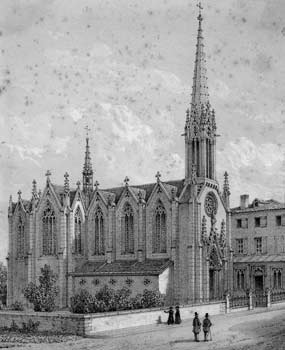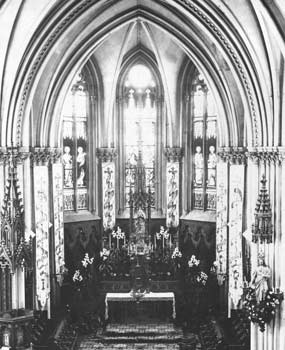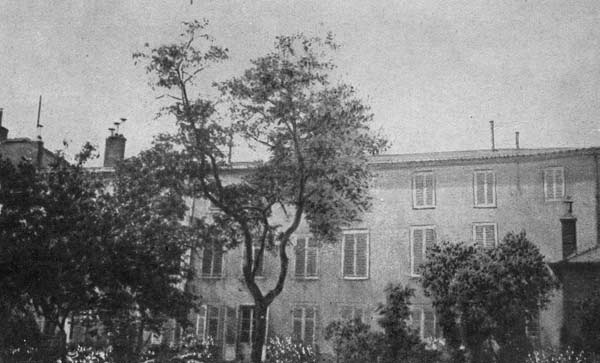- The Foundation
- The Novitiate (1847-1849; 1856-1880)
- The community of mission preachers and its ministry
- Retreats and Missions
- Other Ministry in the City of Nancy
- A few Important Events
The Foundation
At the March 12, 1845 session of the General Council, Father Henry Tempier spoke of the advantages that would accrue to making a foundation in the north of France or in Belgium in order to extend the field of action and the recruitment area for the Congregation and to establish a relay point between the houses of the Midi of France and those of England. The members of the council acknowledged the “judiciousness of these reasons,” but judged that it was impossible to deal with this situation immediately “given the present situation and faced with the necessity of shoring up the already existing houses.”

Nancy, Church exterior (GA).

Nancy, Church interior (GA).
This project became a necessity in 1847. Father Léonard Baveux’s recruiting tour in the seminaries from the end of 1846 to the beginning of 1848 had an unhoped for success. The novitiate of Notre-Dame de l’Osier could no longer receive the many postulants who presented themselves (seventy-three novices in 1847). During his tours, Father Baveux has also had contact with the ecclesiastical authorities in Nancy, Malines and Bruges, in view of establishing a novitiate and a house of mission preachers. At the June 10, 1847 session of the General Council, the decision was made to send Father Tempier to investigate whether “there was something substantial in this project.” As of June 14, Bishop de Mazenod wrote to his friend, Bishop Alexis-Basile Menjaud, initially administrator, then bishop of Nancy from 1837 to 1859, telling him: “I would be happy if you could become a second father to my sons… I dare assure you, and I guarantee that you will never regret having adopted them. The spirit I instil into them and which they have perfectly understood is that they see themselves as the bishop’s men, promising him inviolable submission and affection, making his person and authority respected everywhere and by everyone…” (Oblate Writings I, vol. 13, no. 110, p. 137) At the first news of these plans for a foundation, Bishop Menjaud wrote: “You will not find in France a bishop… better disposed than the bishop of Nancy to support your views for the benefit of religion and the spread of the faith in foreign countries. Your sons will be my sons and they will find in my heart something of the tenderness that is found in your heart…”
By the end of July 1847 already, Father Tempier had travelled to Nancy. He immediately received a letter from the Founder asking him not to go into Belgium. It is impossible to make two foundations at the same time. On August 12, Father Tempier purchased from a Mr. F. J. Thomassin, a house large enough to house fifty or sixty people and immediately adapted it to its future usage. Situated in the southern part of the city on Montet street, it had a garden with outbuildings. On August 17, Bishop de Mazenod praised the speed with which his first assistant concluded the affair, but reproached him for having paid more than the agreed platform price (65.000 francs rather than 45.000 francs) and without previously telling him anything about it. “But 65,000 francs instead of the 45,000 we spoke of, is a bit hard to digest. Father Fabre has already come to see me to plead his poverty.” (Oblate Writings I, vol. 10, no. 939, p. 174)
At the beginning of September, Father Frédéric Mouchel with the title of treasurer took possession of the house . At the end of October, Father Toussaint Dassy, the superior, arrived. Father Jacques Santoni, appointed novice master, followed him a few days later with about ten novices from Notre-Dame de l’Osier.
The Novitiate (1847-1849; 1856-1880)
In February of 1848, the revolution which put an end to the July Monarchy, rendered uncertain the fate of religious and exacerbated the financial situation of the Congregation. On May 24, 1848, the General Council decided to close the novitiate in Nancy. This closing was somewhat delayed as a result of the protests of Father Dassy, but as of the beginning of 1849, they stopped receiving novices. Father Santoni, who, under the rule of Father Ambroise Vincens was used to a good deal of freedom, returned to l’Osier in the spring of 1848. He could not get along with Father Dassy, an exacting superior who controlled everything and, according to the Founder’s way of putting it, always “seems to act as lord and master.” Father Eugène Dorey replaced him as master of novices in 1848-1849.

At the General Chapter of 1856, the decision was taken to re-open the novitiate of Nancy in order to receive the vocations coming from dioceses in the North of France, Belgium and Germany. Father François-Xavier Guinet was appointed novice master; he was replaced for a few months in 1857-1858 by Father Jean-Baptiste Berne. Bishop de Mazenod visited this house in 1849, then in 1857, 1858 and 1859. At the time, he found there a novitiate where the candidates were not numerous but fervent.
Between 1847 and 1880, there were three hundred and twenty-seven takings of the habit in this novitiate which was closed from 1850 to 1855 and then again for fifteen months from in 1870-1871 because it was occupied at the time by Prussian soldiers. Only one hundred and seventy made their first profession. We have in the general archives the register of the taking of the habit and all the monthly reports of the novice master on each candidate.
Thirteen Oblates were novice masters during this period of twenty-six years, for an average of less than two years each, because Fathers Toussaint Rambert, Joseph Zabel and Jean Corne held the post for three years and Father Gustave Simonin held this post from 1871 to 1877.
Among the Oblates who made their novitiate there, three were named bishops: Louis D’Herbomez, vicar apostolic of British Columbia from 1863 to 1890, Charles Jolivet, vicar apostolic of Natal from 1874 to 1903 and Émile Legal, coadjutor and subsequently Bishop of Saint Albert from 1897 to 1912, Archbishop of Edmonton from 1912 to 1920. Ten of them became provincials or vicars of missions, two of whom were provincials of Midi province (Edouard Gandar (1882-1888) and Victor Bourde (1888-1891) and two of France-Nord province (Alfred Voirin (1884-1885) and Charles Brulé (1899-1905).
The community of mission preachers and its ministry
Fifteen priest succeeded each other as superiors of the Nancy community during the course of its thirty-three years of existence, seven of which were from 1847 to 1861. In addition to being a novitiate, Nancy was a house of parish mission preachers. Just as in Limoges, they were expecting the arrival of a few good preachers. As of October 21, 1847, Bishop de Mazenod wrote to Mr. Marguet, the vicar general and superior of the major seminary to inform him of the spirit of the Congregation. He wrote: “You urge me to send you first class individuals while reminding me that at Nancy you are used to being spoiled from having the best preachers that come successively into your region. I will not ask you whether these excellent preachers brought a lot of your people to conversion. That is usually not the case with excellent preachers…” He then copied for him a few excerpts from the rules laying out the method that “our missionaries must follow” to evangelize the poor and added: “I especially wanted to copy this passage in order to elicit your commitment to always maintain our missionaries in the humility of their vocation and not expose them to the danger of doing anything other than what is determined by their Rule.”
A few days earlier, the Founder urged Father Dassy to consult Mr. Marguet with regard to “what approach to take with regard to the parish priests, the clergy and the people of Nancy.” He also advised him not to do too much preaching in the city. He told him: “It is not for us to compete with the great preachers that we are used to hearing in the cities. Our vocation does not lie in that.”
Retreats and Missions
Upon his arrival in Nancy, Father Dassy visited the twenty-one religious communities in the city. The Jesuits and the “Liguorians” were very much in demand for preaching retreats and told him that in that area people were rather biased against the word mission and ostentatious ceremonies rather than the reality of mission, but the parish priests did not want missions that lasted more than two weeks. On December 7, 1847, the Founder wrote to congratulate him “for being the first of our Congregation to announce the Word of God to those frozen people of the north.” (Oblate Writings I, vol. 10, no. 956, p. 193) He then urged him to be patient. He added: “Since these people, according to what you write me, do not wish to take advantage of our ministry, we must believe that we will finally conquer their aversion for these holy missions which accomplish such marvels elsewhere.” (Oblate Writings I, vol. 10, no. 956, p. 193)
From 1847 to 1851, operating alone, the superior preached two retreats in 1847; seven in 1848, eleven in 1849 and sixteen in 1850, with the assistance in this last year of Father César Albert Depetro whom the Founder had sent to Nancy to be trained in the ministry of preaching under the direction of Father Dassy. After the departure of the last novices at the end of 1849, Bishop de Mazenod sent a few priests to Nancy to establish a genuine religious missionary community, more specifically, Fathers Hector Merlin, the superior, Jean Conrard, Louis Souillier, and later on, Charles Baret, Alexandre Audruger, Jean Jeanmaire, Joseph Bonnard, etc. Right up until 1861, the community always counted among its membership a few brothers and six or seven priests who, each year, preached from twenty to thirty retreats or missions.
After the death of the Founder, the number of Oblates at Nancy hardly ever changed: five or six mission preachers, a few brothers and the master of novices. Almost every year the review Missions O.M.I. published the report the Nancy superior submitted to the General Administration. Usually, they preached between thirty and fifty retreats and missions each year in six or seven dioceses. In his 1866 report, Father Zabel even mentions sixty-six ministry engagements during the year. In 1868, Father Martignat, the superior, wrote: “Although the people of Lorraine display a somewhat frigid exterior when compared to the people of Midi, they are very open to the grace of missions.” In 1869, this priest mentions seventy-one ministry engagements in five dioceses.
Other Ministry in the City of Nancy
In 1853, the bishop asked the Oblates to take on the chaplaincy of the prisons in the city. Father Eugène Dorey, the first chaplain, immediately caught typhus fever and died in March of that same year. Father Jean Jeanmaire took his place and, after him, other priests until 1880.
In October 1849, the community chapel was thrown open to the public for Mass and confessions. This gothic chapel, “an architectural gem” was built from 1858 to 1860. Bishop Georges Darboy, the bishop of Nancy from 1859 to 1863, solemnly blessed the chapel on August 12, 1860 in the presence of eleven mission preachers, thirty novices and five brothers. Three organizations would use it as their centre for meetings and retreats: the Women Domestic Servants and the Women Workers as of 1859, the Perseverance, a mutual help group, and the Confraternity of the National Vow to the Sacred Heart, founded by Father Jean Jeanmaire in 1877. One of the priests also assumed the direction of the novices of the Congregation of Christian Doctrine.
A few Important Events
In 1849 Bishop Menjaud suggested the Oblates establish a community at Notre-Dame de Sion, the oldest and most famous pilgrimage site in all of Lorraine. Father Dassy wrote immediately to Marseilles and suggested the sale of the house at Nancy in order to establish the community near the shrine in an unoccupied building. Father Tempier responded: “In such a matter, we must not consider your tastes and particular views, but also consult the tastes and views of others. Well, since almost no one shares your admiration and your enthusiasm for the mountains of Sion… uninhabitable for at least six months of the year, exposed to all the winds, without shade in front … a vast building with only four rooms and dormitories…” Upset by this response, Father Dassy copied this text in a letter he wrote to the Founder on March 2 and added: “What language, what serious things in these few lines…; I do not feel I have the courage to answer directly…” On March 10, Bishop de Mazenod responded to his letter with a few words of consolation, but without changing the decision made by Father Tempier: “I understand, my most dear Father Dassy, all that must have hurt you in the last letter you received from Father Tempier, but I must reject the implications you draw therefrom. Be fully convinced that we do entire justice to your excellent sentiments, that we are more than convinced of the zeal which motivates you for the good and the honor of the Congregation, and that, if in this circumstance we reached an opinion other than yours, it is only because we have judged that, in our present situation, this acquisition does not seem appropriate… Start from the principle that we no longer wish to establish houses outside cities and especially in the far countryside; we already have enough and too many of this type. Make the most of your residence at Nancy.” (Oblate Writings I, vol. 10, no. 1002, p. 247)
In 1850, Father Dassy accepted the pastoral responsibility of Notre-Dame de Sion where Fathers Conrard and Soullier succeeded each other by turns. They had to foil and defeat the campaign being waged by the Baillard brothers who were entrenched in that area and who were in revolt against their bishop. They had become partisans of the errors taught by a visionary by the name of Vintras, the founder of a sect. Bishop de Mazenod did not demand that the superior recall these priests, but he wrote on October 29: “It is no mean task, my dear friend, that you have taken on and simple missionaries will not be able to enter into continuous face-to-face combat with sectarians of the ilk of these Brothers Baillard. Is it not a mistake to send our young men all alone to this fearful battleground? In your place, I would have declined so delicate a charge; you had a good excuse to hand, namely, that our men have always to go out in pairs and your community is not sufficiently numerous to spare two men. I can see you now: your zeal is aroused by an account of the evil done by these apostates and as your primary impulse is always to follow whatever your zeal dictates, you did not pause to reflect on the difficulties that this delicate mission presents.” (Oblate Writings I, vol. 11, no. 1055, p. 28) In 1853-1854, an Oblate house was opened at Notre-Dame de Sion under the directorship of Father Conrard.
In 1876, Father Bourde, the superior, purchased for the sum of 34,000 francs a property next to the house in Nancy in order to expand the garden area and to give more space for the novices. He had not foreseen government persecution of the religious. Indeed, on November 4, 1880, the local militia locked and sealed the chapel and forcibly evicted the priests and brothers of the community.
During the course of the expulsions of 1880, the religious retained ownership of their buildings. Almost everywhere, they returned quietly to their houses without being disturbed. In Nancy, the Oblates immediately put their property up for sale and set in motion negotiations in this regard with the bishop, Bishop J. A. Foulon. Without doubt, they preferred, as Father Dassy had previously suggested, to regroup around the Virgin at Notre-Dame de Sion. Bishop Frouillet, parish priest of Saint-Epvre, bought the property in May of 1882 at a cost of 225,000 Francs. In addition to this, he committed himself to paying off the 50,000 francs debt the Oblates were carrying. In 1895, this house was bought by the Sisters of Saint Charles who reside there even today.
Yvon Beaudoin, o.m.i.
